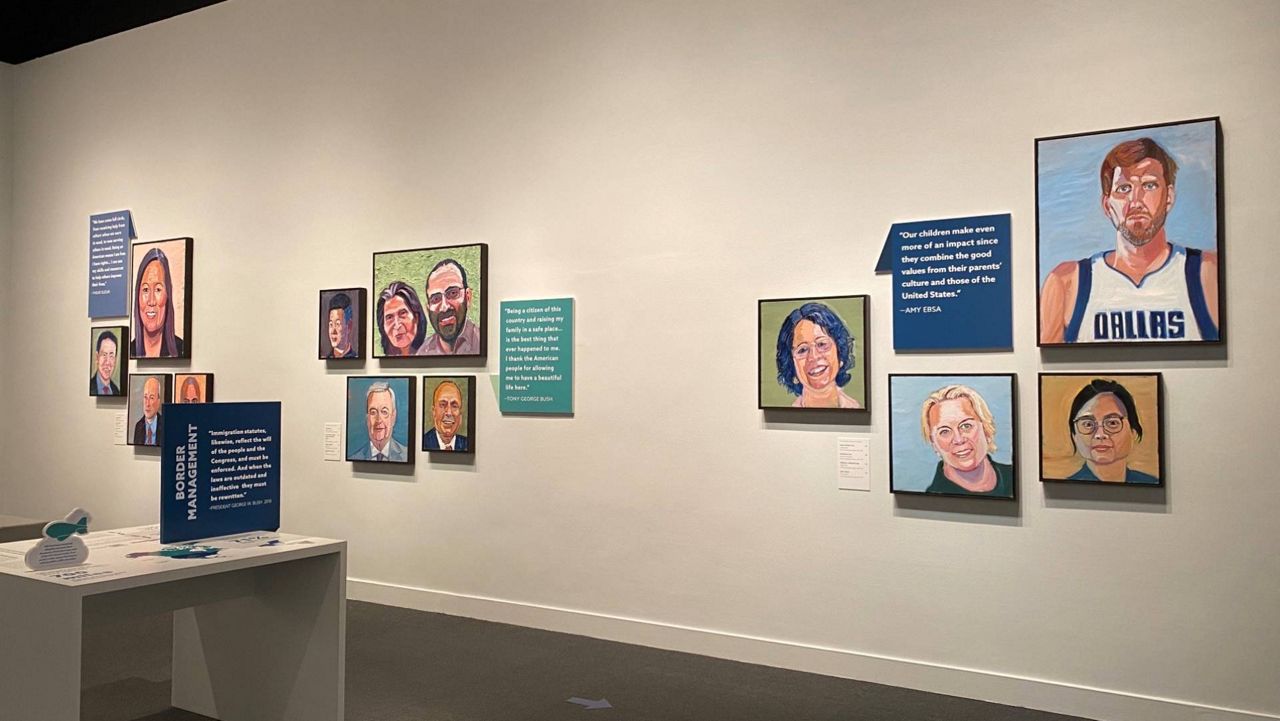DALLAS — Many of the names and faces on the wall are well known: Madeleine Albright, an immigrant from Czechoslovakia, who became the first female U.S. secretary of state. Henry Kissinger, whose family fled Nazi Germany in 1938, and later became a U.S. secretary of state and a Nobel Peace Prize winner.
Others are less well known, such as Joseph Kim, who fled North Korea and later joined the Bush Center as an expert-in-residence, or Philip Alier Machok, who as a young boy became one of some 20,000 displaced youth known as the Lost Boys of Sudan’s brutal civil war. Machok is now a volunteer at the Bush Center’s museum and exhibit halls.
But all of their faces and stories come together to tell the broader story of immigrants who have contributed to the diversity and uniqueness of America, as depicted in a new exhibit called “Out of Many, One” at the George W. Bush Presidential Center in Dallas. The exhibit, which opened to the public on April 20, is a collection of portraits painted by the forty-third president of the United States, each one depicting the face of an immigrant who has contributed to the diversity and uniqueness of America.
The exhibit includes the original oil paintings created by the former president, as well as multimedia exhibits addressing the Bush Center’s policy suggestions for immigration reform in America. A large, flow-chart like diagram spread across an entire wall of the exhibit takes the visitor through the multiple layers and hurdles immigrants must take in order to obtain a Green Card in the U.S.
Information stands placed through the exhibit room explain the Bush Center’s immigration policy recommendations, using graphics and data to discuss subjects such as why so-called “Dreamers” should be allowed to apply for citizenship as well as explaining why the U.S. should find a rigorous, fair process for undocumented immigrants to get right with the law
The exhibit’s opening coincides with the release of Bush’s book with the same title, which contains 43 portraits and short stories about each of the people profiled. “Out of Many, One” is the second book published that features the president’s artwork since he left the White House in 2009.
Bush served as Texas governor from 1995 to 2000 before serving two terms as president.
Bush took up painting as a hobby after leaving the Oval Office, at first focusing on portraits in oil of world leaders, still life, and family dogs. Ahead of his first exhibit in 2014, which included portraits of former British Prime Minister Tony Blair and Russian President Vladimir Putin, he confessed that he was “not a great painter."
He later published a collection of portraits and stories about U.S. military veterans in his first book, “Portraits of Courage,” in 2017.
The opening of “Out of Many, One” comes at a time when immigration policy is at the forefront of challenges facing President Joe Biden. The U.S. southern border has seen a surge in Central American and Mexican migrants this year in the latest wave of asylum seekers and others. Tens of thousands of underage migrants have attempted to enter the U.S. through Mexico, putting a strain on the Border Control and immigration agencies during the pandemic.
The timing of the exhibit was a coincidence, however, said Laura Collins, the director of the Bush Institute-SMU Economic Growth Initiative, the nonpartisan policy institute located within the George W. Bush Presidential Center.
“One of the things we know about immigration is that every few years migration events at the border happen,” she said. “That was true under President Bush, President Obama, President Trump and now President Biden.”
With the exhibit scheduled to be up until early 2022, a new migration event during that time frame was “bound to happen,” she said.
But the timing of it “allows us to have some good, solutions-oriented policy out here for the public to see at a time when people are really paying attention to immigration,” Collins said.
“Out of Many, One” runs until Jan. 3, 2022. Tickets can be purchased on the Bush Center’s website and will come with a timed entry to accommodate for COVID-19 protocols currently in place at the center.



